Mikhail Hushchyn
Global Optimisation of Black-Box Functions with Generative Models in the Wasserstein Space
Jul 16, 2024



Abstract:We propose a new uncertainty estimator for gradient-free optimisation of black-box simulators using deep generative surrogate models. Optimisation of these simulators is especially challenging for stochastic simulators and higher dimensions. To address these issues, we utilise a deep generative surrogate approach to model the black box response for the entire parameter space. We then leverage this knowledge to estimate the proposed uncertainty based on the Wasserstein distance - the Wasserstein uncertainty. This approach is employed in a posterior agnostic gradient-free optimisation algorithm that minimises regret over the entire parameter space. A series of tests were conducted to demonstrate that our method is more robust to the shape of both the black box function and the stochastic response of the black box than state-of-the-art methods, such as efficient global optimisation with a deep Gaussian process surrogate.
Performance Modeling of Data Storage Systems using Generative Models
Jul 05, 2023Abstract:High-precision modeling of systems is one of the main areas of industrial data analysis. Models of systems, their digital twins, are used to predict their behavior under various conditions. We have developed several models of a storage system using machine learning-based generative models. The system consists of several components: hard disk drive (HDD) and solid-state drive (SSD) storage pools with different RAID schemes and cache. Each storage component is represented by a probabilistic model that describes the probability distribution of the component performance in terms of IOPS and latency, depending on their configuration and external data load parameters. The results of the experiments demonstrate the errors of 4-10 % for IOPS and 3-16 % for latency predictions depending on the components and models of the system. The predictions show up to 0.99 Pearson correlation with Little's law, which can be used for unsupervised reliability checks of the models. In addition, we present novel data sets that can be used for benchmarking regression algorithms, conditional generative models, and uncertainty estimation methods in machine learning.
Toward an understanding of the properties of neural network approaches for supernovae light curve approximation
Sep 15, 2022



Abstract:The modern time-domain photometric surveys collect a lot of observations of various astronomical objects, and the coming era of large-scale surveys will provide even more information. Most of the objects have never received a spectroscopic follow-up, which is especially crucial for transients e.g. supernovae. In such cases, observed light curves could present an affordable alternative. Time series are actively used for photometric classification and characterization, such as peak and luminosity decline estimation. However, the collected time series are multidimensional, irregularly sampled, contain outliers, and do not have well-defined systematic uncertainties. Machine learning methods help extract useful information from available data in the most efficient way. We consider several light curve approximation methods based on neural networks: Multilayer Perceptrons, Bayesian Neural Networks, and Normalizing Flows, to approximate observations of a single light curve. Tests using both the simulated PLAsTiCC and real Zwicky Transient Facility data samples demonstrate that even few observations are enough to fit networks and achieve better approximation quality than other state-of-the-art methods. We show that the methods described in this work have better computational complexity and work faster than Gaussian Processes. We analyze the performance of the approximation techniques aiming to fill the gaps in the observations of the light curves, and show that the use of appropriate technique increases the accuracy of peak finding and supernova classification. In addition, the study results are organized in a Fulu Python library available on GitHub, which can be easily used by the community.
Latent Neural Stochastic Differential Equations for Change Point Detection
Aug 22, 2022



Abstract:The purpose of change point detection algorithms is to locate an abrupt change in the time evolution of a process. In this paper, we introduce an application of latent neural stochastic differential equations for change point detection problem. We demonstrate the detection capabilities and performance of our model on a range of synthetic and real-world datasets and benchmarks. Most of the studied scenarios show that the proposed algorithm outperforms the state-of-the-art algorithms. We also discuss the strengths and limitations of this approach and indicate directions for further improvements.
Supernova Light Curves Approximation based on Neural Network Models
Jun 27, 2022



Abstract:Photometric data-driven classification of supernovae becomes a challenge due to the appearance of real-time processing of big data in astronomy. Recent studies have demonstrated the superior quality of solutions based on various machine learning models. These models learn to classify supernova types using their light curves as inputs. Preprocessing these curves is a crucial step that significantly affects the final quality. In this talk, we study the application of multilayer perceptron (MLP), bayesian neural network (BNN), and normalizing flows (NF) to approximate observations for a single light curve. We use these approximations as inputs for supernovae classification models and demonstrate that the proposed methods outperform the state-of-the-art based on Gaussian processes applying to the Zwicky Transient Facility Bright Transient Survey light curves. MLP demonstrates similar quality as Gaussian processes and speed increase. Normalizing Flows exceeds Gaussian processes in terms of approximation quality as well.
The Tracking Machine Learning challenge : Throughput phase
May 14, 2021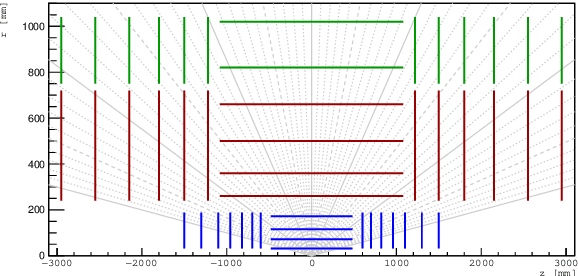
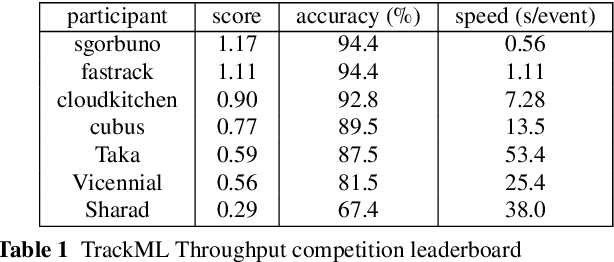
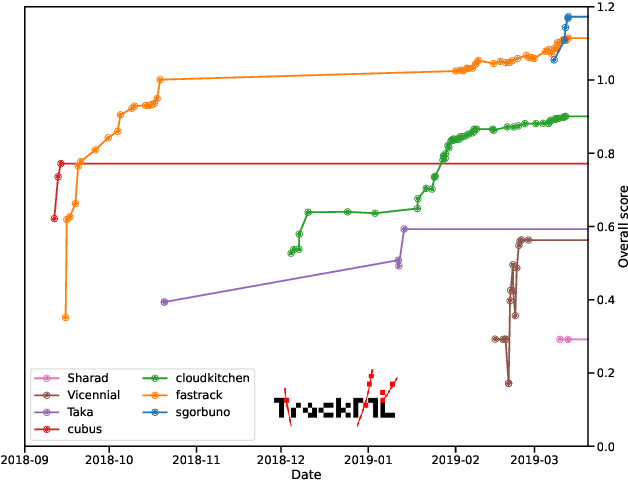
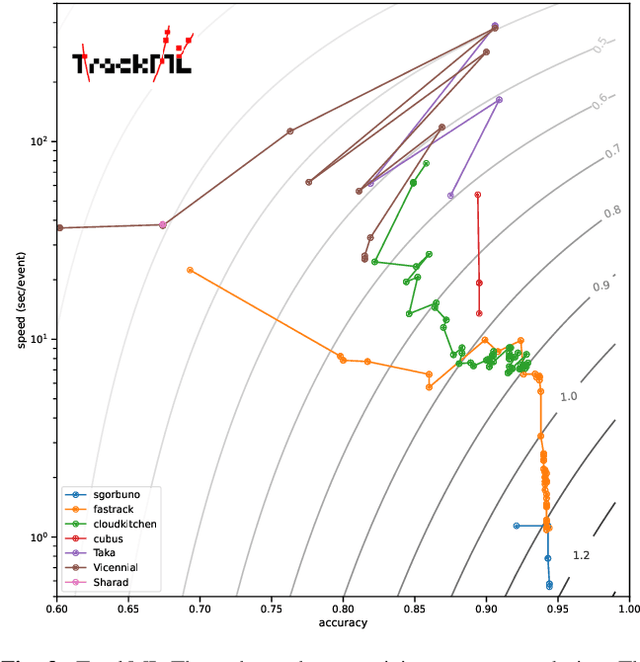
Abstract:This paper reports on the second "Throughput" phase of the Tracking Machine Learning (TrackML) challenge on the Codalab platform. As in the first "Accuracy" phase, the participants had to solve a difficult experimental problem linked to tracking accurately the trajectory of particles as e.g. created at the Large Hadron Collider (LHC): given O($10^5$) points, the participants had to connect them into O($10^4$) individual groups that represent the particle trajectories which are approximated helical. While in the first phase only the accuracy mattered, the goal of this second phase was a compromise between the accuracy and the speed of inference. Both were measured on the Codalab platform where the participants had to upload their software. The best three participants had solutions with good accuracy and speed an order of magnitude faster than the state of the art when the challenge was designed. Although the core algorithms were less diverse than in the first phase, a diversity of techniques have been used and are described in this paper. The performance of the algorithms are analysed in depth and lessons derived.
Online detection of failures generated by storage simulator
Jan 18, 2021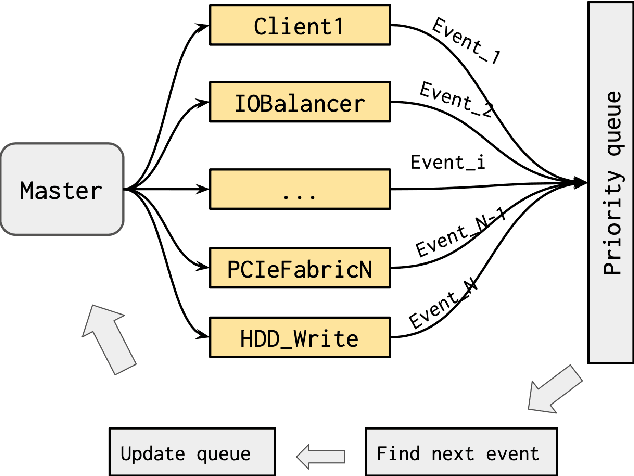

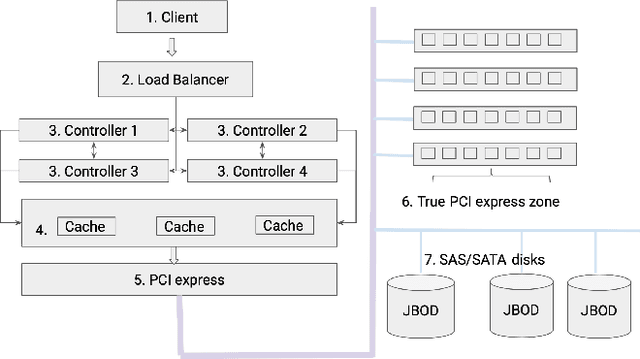
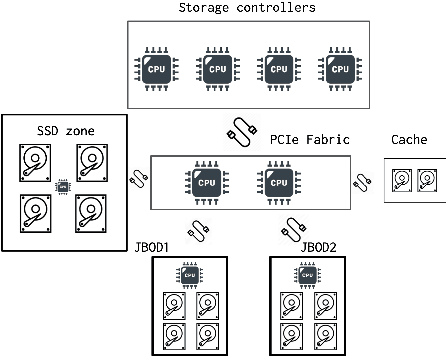
Abstract:Modern large-scale data-farms consist of hundreds of thousands of storage devices that span distributed infrastructure. Devices used in modern data centers (such as controllers, links, SSD- and HDD-disks) can fail due to hardware as well as software problems. Such failures or anomalies can be detected by monitoring the activity of components using machine learning techniques. In order to use these techniques, researchers need plenty of historical data of devices in normal and failure mode for training algorithms. In this work, we challenge two problems: 1) lack of storage data in the methods above by creating a simulator and 2) applying existing online algorithms that can faster detect a failure occurred in one of the components. We created a Go-based (golang) package for simulating the behavior of modern storage infrastructure. The software is based on the discrete-event modeling paradigm and captures the structure and dynamics of high-level storage system building blocks. The package's flexible structure allows us to create a model of a real-world storage system with a configurable number of components. The primary area of interest is exploring the storage machine's behavior under stress testing or exploitation in the medium- or long-term for observing failures of its components. To discover failures in the time series distribution generated by the simulator, we modified a change point detection algorithm that works in online mode. The goal of the change-point detection is to discover differences in time series distribution. This work describes an approach for failure detection in time series data based on direct density ratio estimation via binary classifiers.
Online Neural Networks for Change-Point Detection
Oct 03, 2020



Abstract:Moments when a time series changes its behaviour are called change points. Detection of such points is a well-known problem, which can be found in many applications: quality monitoring of industrial processes, failure detection in complex systems, health monitoring, speech recognition and video analysis. Occurrence of change point implies that the state of the system is altered and its timely detection might help to prevent unwanted consequences. In this paper, we present two online change-point detection approaches based on neural networks. These algorithms demonstrate linear computational complexity and are suitable for change-point detection in large time series. We compare them with the best known algorithms on various synthetic and real world data sets. Experiments show that the proposed methods outperform known approaches.
Photometric Data-driven Classification of Type Ia Supernovae in the Open Supernova Catalog
Jun 18, 2020



Abstract:We propose a novel approach for a machine-learning-based detection of the type Ia supernovae using photometric information. Unlike other approaches, only real observation data is used during training. Despite being trained on a relatively small sample, the method shows good results on real data from the Open Supernovae Catalog. We also demonstrate that the quality of a model, trained on PLASTiCC simulated sample, significantly decreases evaluated on real objects.
Variational Dropout Sparsification for Particle Identification speed-up
Jan 21, 2020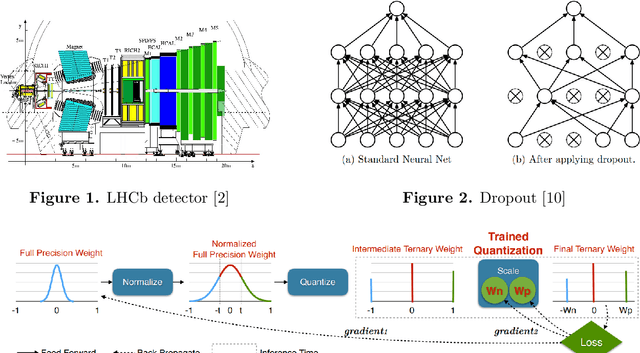

Abstract:Accurate particle identification (PID) is one of the most important aspects of the LHCb experiment. Modern machine learning techniques such as neural networks (NNs) are efficiently applied to this problem and are integrated into the LHCb software. In this research, we discuss novel applications of neural network speed-up techniques to achieve faster PID in LHC upgrade conditions. We show that the best results are obtained using variational dropout sparsification, which provides a prediction (feedforward pass) speed increase of up to a factor of sixteen even when compared to a model with shallow networks.
 Add to Chrome
Add to Chrome Add to Firefox
Add to Firefox Add to Edge
Add to Edge